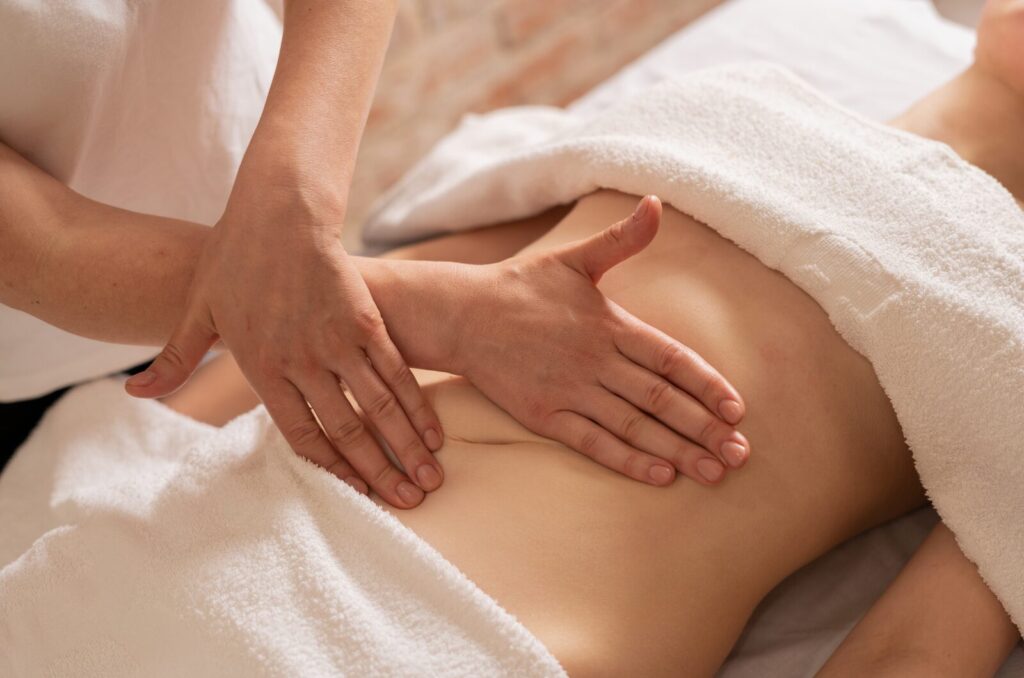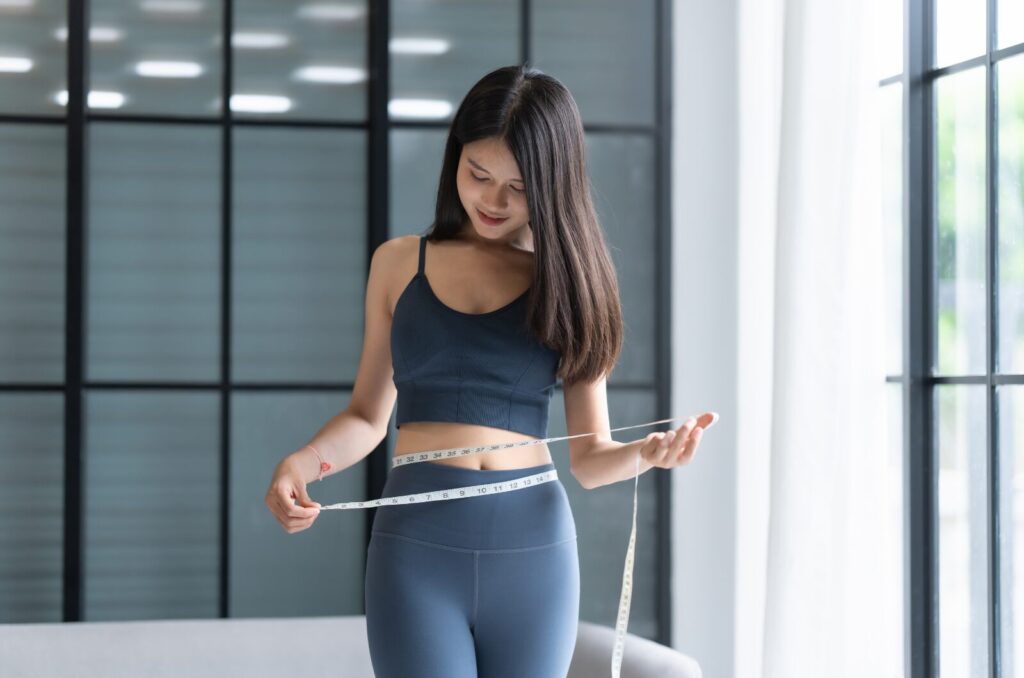Monthly discomfort and pain in women occur due to hormonal changes, inflammation, fluid retention, and muscle tension during the menstrual cycle. These factors contribute to common symptoms such as cramps, bloating, fatigue, and heaviness. Lymphatic drainage massage benefits women by stimulating the lymphatic system to improve lymph flow, reducing inflammation, and excess fluid buildup.
This helps alleviate swelling, eases discomfort, and supports the body’s natural detoxification processes, promoting overall comfort and well-being during the menstrual cycle. Women in San Diego can find relief and improved balance through this gentle, effective therapy.
How Does Lymphatic Drainage Work During Monthly Discomfort?
Lymphatic drainage massage benefits women by arousing the lymphatic system, which removes excess fluid, waste products, and inflammatory substances from tissues. During the menstrual cycle, hormonal changes lead to increased inflammation, fluid retention, and tissue swelling. This causes discomfort such as bloating, heaviness, and cramps.
Struggling with swelling, fatigue, or post-surgery recovery?
Book your personalized lymphatic drainage session today and experience natural, therapeutic healing that restores balance and promotes long-term wellness.
Book an AppointmentLymphatic drainage massage San Diego therapists help reduce these symptoms by clearing lymph fluid buildup and calming inflammation. Additionally, this therapy supports detoxification and helps regulate the nervous system, which reduces pain sensitivity and improves overall hormonal balance. The gentle, rhythmic movements used in lymphatic drainage facilitate natural healing and comfort, making it an effective approach to managing monthly discomfort and promoting well-being throughout the menstrual cycle.
How Does Lymphatic Drainage Help with Period Cramps and Hormonal Balance?

Lymphatic drainage massage supports women through their menstrual cycle by easing period cramps, reducing bloating and water retention, supporting hormone regulation, and providing overall cycle-related benefits. Each of these benefits plays a crucial role in relieving discomfort and promoting hormonal balance throughout the month, enhancing the body’s natural detoxification and repair mechanisms.
Help With Period Cramps
Does lymphatic drainage massage help with period cramps? Yes, by reducing inflammation and muscle tension in the pelvic region. The gentle, rhythmic movements stimulate lymph flow, clearing out inflammatory compounds like prostaglandins that increase cramping. Additionally, this therapy calms the nervous system. Resultantly, it reduces pain sensitivity and relaxes uterine muscles, which helps ease painful contractions and discomfort effectively.
Reduce Bloating and Water Retention
Hormonal changes during menstruation cause fluid to accumulate in tissues, leading to bloating. Lymphatic drainage encourages the removal of excess interstitial fluid by improving lymphatic circulation. This drainage helps reduce puffiness and swelling in the abdomen, hips, and legs. As such, it eases discomfort and makes movement more comfortable during the menstrual period.
Support Hormone Regulation
Efficient lymphatic drainage supports the body’s ability to clear excess hormones, such as estrogen, that fluctuate during the menstrual cycle and contribute to symptoms like mood swings and cramps. Aiding toxin and hormone removal ensures this therapy maintains hormonal balance, reduces the severity of PMS symptoms, and improves overall reproductive health.
Benefits during the Menstrual Cycle
Lymphatic drainage promotes detoxification, reduces systemic inflammation, and enhances calmness by activating the parasympathetic nervous system. These effects support the body’s natural hormonal reset after menstruation, enhance energy levels, stabilize mood, and promote a greater sense of well-being throughout the entire cycle. Regular lymphatic care contributes to smoother, more comfortable monthly cycles overall.
Is Lymphatic Drainage Safe During Menstruation?
Lymphatic drainage massage benefits women during menstruation and is a safe and effective way to ease menstrual-related symptoms, such as bloating, cramping, and fatigue. The lymphatic flow naturally increases during menstruation due to hormonal changes and inflammation. Thus, gentle stimulation through manual lymph drainage helps minimize fluid retention and relieve pressure in the abdominal and pelvic areas. The technique involves soft, rhythmic strokes that promote detoxification while calming the nervous system, which can decrease pain sensitivity and support hormonal balance.
It is important, however, to communicate openly with your certified lymphatic drainage therapist about your menstrual cycle to ensure the massage is adjusted for optimal comfort. Some women may experience increased sensitivity during their period, so therapists will modify pressure and techniques accordingly. When performed correctly by a trained professional, lymphatic drainage during menstruation is safe, enhances relief from discomfort, and supports the body’s natural healing and detoxification processes.
What Should You Expect from a Lymphatic Drainage Session?
During a session, you will experience the gentle, precise techniques that make lymphatic drainage massage benefits so effective. The therapist uses light, rhythmical strokes to arouse the lymphatic system and stimulate the flow of lymph fluid, especially focusing on key lymph node areas like the neck, armpits, and groin. This encourages detoxification and reduces swelling or fluid retention. Sessions last between 30 and 60 minutes, tailored to your specific needs.
Practitioners of lymphatic drainage massage San Diego combine expert knowledge with personalized care, ensuring each massage supports optimal lymph flow and overall health. After treatment, you may feel lighter, relaxed, and notice reduced puffiness or discomfort. Hydration, gentle exercise, and self-care recommendations accompany sessions to maintain the benefits and promote ongoing lymphatic health. This holistic approach enhances the body’s natural detoxification, supporting wellness and recovery.
Conclusion
Lymphatic drainage massage benefits your overall health by promoting detoxification, reducing swelling, boosting immunity, and enhancing relaxation. At Lymphatic Therapy Services in San Diego, our expert therapists use gentle, precise techniques tailored to your unique needs.
If you are seeking relief from monthly discomfort or post-surgical swelling, our personalized care supports improved lymph flow and faster recovery. Enjoy the healing power of lymphatic drainage massage benefits for yourself. Book an appointment today to start your journey toward better health and comfort.
FAQs
Does Lymphatic Drainage Help With Period Cramps Immediately?
Lymphatic drainage massage offers quick relief from period cramps and pain minutes into or after the session. It does this by reducing inflammation and promoting lymph flow. This massage technique eases tension in pelvic muscles and encourages detoxification, which leads to noticeable pain reduction soon after the session. However, the speed and extent of relief differ from person to person depending on individual conditions and the severity of symptoms.
How Often Should Women Get Lymphatic Drainage for PMS or Period Relief?
For sustained relief from PMS or menstrual discomfort, weekly lymphatic drainage sessions are recommended leading up to and during the menstrual cycle. Regular treatment helps maintain balance in lymph flow, reduces inflammation, and manages symptoms effectively over time.
Can I Get A Lymphatic Drainage Massage During My Actual Period?
Yes, lymphatic drainage massage is safe during menstruation. Skilled therapists adjust techniques to accommodate comfort and increased sensitivity. This gentle massage supports symptom relief without interfering with natural cycle processes.
Where Can I Find Trusted Lymphatic Drainage Massage In San Diego?
Trusted lymphatic drainage massage San Diego is found at Lymphatic Therapy Services. We offer experienced therapists trained in lymphatic drainage massage and personalized care tailored to women’s health needs.
What’s The Difference Between Lymphatic Drainage And Regular Massage For Period Pain?
Lymphatic drainage massage specifically targets the lymphatic system to reduce fluid retention, inflammation, and toxin buildup, which directly affect period pain. Regular massage mainly addresses muscle tension and relaxation, but doesn’t actively promote lymph flow or detoxification.
Is Lymphatic Drainage Safe If I Have Endometriosis Or PCOS?
Lymphatic drainage massage is safe for women with endometriosis or PCOS when done by professional therapists. It helps reduce inflammation and fluid retention related to these conditions. However, it would help to consult with your healthcare provider before starting any new therapy.



















